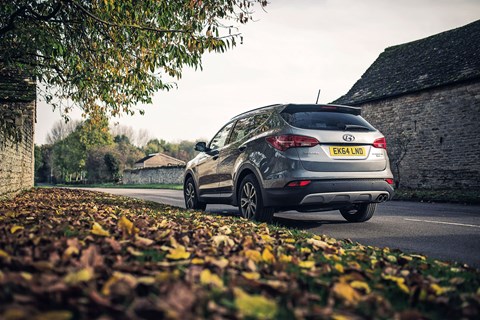► Eight months in Hyundai’s SUV
► Roomy, affordable and practical
► CAR magazine’s full long-term test
Month 8 running a Hyundai Santa Fe: the conclusion of our long-term test
If it hadn’t been for peskily unseasonable weather we might have given the Santa Fe a harder time in Kielder Forest. This was to be the moment of truth, the bit where our likeable Korean SUV finally tiptoed beyond the verge and revealed itself to be officially ‘no Land Rover’. A week earlier, our recce team claim, these green lanes were muddier than a Mississippi pie, but today they’re baked hard.
Still, we try. After all, I’ve driven 300 miles to be here, and in the process further reinforced the Hyundai’s credentials as a sublime consumer of motorways. Its ride is composed like a symphony, flattening other-planet-spec surfaces yet still offering up enough feedback to keep you interested. Although no kind of performance car, once the Santa Fe tastes the torque cream at around 2000rpm it hauls and hauls, pretty much non-stop to Kielder – still in England but a fraction north of Sturgeon’s Wall.
Weirdly, almost none of that composure dissolves once we’re off the road, through the farm gate and into the tractor ruts. Maybe that’s because there’s not a world of difference between UK A-roads and farm tracks, or maybe it’s testament to Hyundai’s UK-tuned suspension, in which stiffer dampers, revised mounting bushes and a rear trailing arm connected to a chassis cross-member achieve alchemy.
That said, the further we delve into nowhere the more it feels like we have extra work to do. On the road there’s rarely much fun to derive from switching the six-speed auto ’box to Sport mode, but right now we need to call on more control through engine braking (arguably Sport is exactly the wrong name for this setting – how about Manual?). Even with the stick set left however, the Santa Fe’s ‘on demand’ 4wd system stubbornly sticks to its front-wheel-drive-wherever-possible remit, showing the same appetite for directing torque rearwards as a president has for pressing the nuke button. On-demand? Clearly I need to demand more loudly.
The solution is to hit the diff-lock switch, which holds the torque distribution at 50/50, front-to-rear. At this point confidence soars, though ironically you find yourself going a bit faster as a result. Cue dark looks from farmer. And when we finally encounter a steepish slope greasier than last night’s kebab, I play Santa Fe’s last card: hill descent control. Now we’re in proper off-road trim, nose pointing down, foot off the brake pedal, listening to the frankly alarming noise the system makes as it brakes various wheels independently and triggers the ABS over and over again. But it works, dammit. We traverse to the foot of the slope at sub-5mph, with no steering or pedal inputs of any kind required.
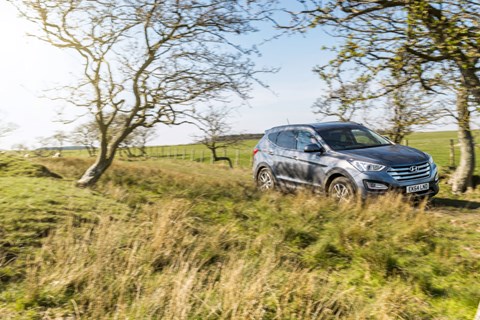
No doubt the oily-fingernailed, desert-booted brigade at Land Rover’s Gaydon HQ will sneer at this modest test, but for me the Santa Fe has proved something today. It’s shown it can do anything you’re ever likely to require of it, even if you sign cheques ‘B Grylls’. It’s a misnomer to call it a ‘soft-roader’ – it’s better than that.
Back on the road, clumps of mud now flinging randomly from the wheelarches, I leave the gearbox in Sport and commence some first-class hooning along Forestry Commission trails through Kielder more potholed than a Yemeni runway, reacquainting myself with how small this big SUV can feel when chucked. We’re on our way up to the Kielder Observatory, from where, under the darkest skies in Europe, we’ll witness the simply astonishing Lyrid meteor shower, a display of celestial pyrotechnics the like of which I have never seen. Reflected in the Santa Fe’s still-a-bit-shiny-in-places metallic paint (which at £585 was the only cost-option on our car) we see dozens of what appear to be shooting stars, but are in fact dust trails emanating from fragments of Comet Thatcher. Like, wow.
Compared to matters of the universe the mystery of the Hyundai’s fuel consumption over the past seven months ranks quite low, but I could never shift it over 35mpg, even when mincing about like Julian Clary in panto. They only claim 41.5, which says little for the newly fettled diesel with its variable geometry turbocharger, despite claimed 5.8% efficiency gains over its predecessor.
If you want an upside, though, check out those fantastic residual values. Even as a part-ex we’ve shed only £7k, a testament perhaps to Hyundai’s generous standard equipment, transferable five-year warranty and increasing reputation for bulletproofness. The only problem I can see is that there’s no way I’d want to unload this car after the mere half-year we’ve kept it. It feels like the kind of vehicle you’d run into the ground or pass to your kids, rather than chop-in – just like Land Rovers used to be.
So, whoever’s doing the seating plan for the SUV party, set an extra place at the top table. Hyundai’s earned it, even before we get to Tucson.
By Greg Fountain
Month 7 running a Hyundai Santa Fe 2.2 CRDi Premium: a 1600-mile French road trip
The Santa Fe was my first port of call when planning the Pollard family summer holiday. As the lucky sod who’s spent half a year tooling around in CAR magazine’s second-hand Porsche 997, I had to make alternative arrangements when it came to a fortnight’s vacation on the Continent. Those 911 rear seats and ‘frunk’ are only so accommodating – and no match for the full five-seater Hyundai SUV. Deal struck with keeper Greg Fountain, tank brimmed and yellow coats/breathalysers/other French road trip accessories packed, it was time to say bon voyage and head for the ferry.
Packing a Santa Fe filled me with fear at first. I was surprised by how high the boot was, but then I whisked out the fake floor, discarded the polystyrene storage tub beneath and realised I could stash loads of clobber underneath the regular boot. The official loadbay stands at 585 litres (pretty big) and with the double-decker system removed it meant three large soft bags fitted below where the floor would normally sit. Result? Everything fitted easily, even long awkward items like children’s fishing nets. We even managed to close the luggage cover to keep prying eyes at bay (though the smoked glass is so dark, it does an effective job of hiding possessions regardless).
Driving down to Portsmouth, the Santa Fe shrugged off the full load. This is one relaxed car, its auto ‘box suited to the demands of a long, lazy road trip. That 2.2 turbodiesel isn’t the last word in refinement, but its performance is well judged and I never wanted for extra power or torque. Hyundai does this well; focusing its engineering on the modest demands of everyday owners, not Nurburgring laptimes or desert-crossing ability: high-walled 18in tyres soaking up road patter, the slusher blurring gearchanges quietly and the cabin accommodating a family of four in a high degree of comfort. It’s aimed at the mainstream and all the better for it.
Crossing via Brittany Ferries’ (0871 244 0744) overnight ferry to St Malo proved a godsend – we dodged all the mayhem unfolding at Calais and slept on the giant 580-car Bretagne ferry, arriving at 8am to complete the final leg of our journey south. Negotiating the cramped confines of a ferry hold wasn’t tricky in the Santa Fe (unlike, say, a Range Rover) and once released onto the autoroute we found the sat-nav easy to operate – and it didn’t let us down once in our two weeks away; only the lack of DAB digital radio irked, meaning we were stuck with FM Français for most of our trip, missing out on the drama unfolding in the 2015 Ashes. Hey-ho, the whole point of a holiday is to get away, non?
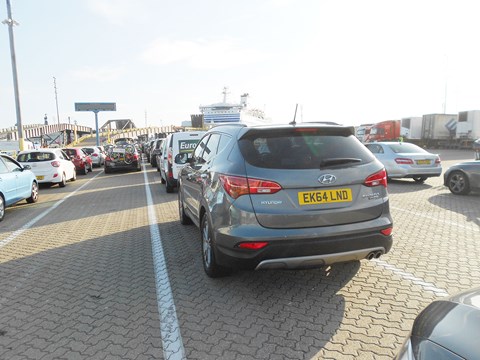
What followed was this: two weeks of schlepping to the beach, slinging towels and buckets and sunshades in the boot, cranking the air-con to its coolest setting (ice-cold, for both rows), admiring the elevated view out of the Santa Fe, wiping suncream off the leather seats, squeezing into tight parking spaces (it’s rightsized, this car), the 4wd never required even on sandy campsite inclines, feeling so confident about the bootspace we bought two new bodyboards and wondering how the optional £585 Titanium Silver metallic hid the dirt so well.
Grumbles are few and far between. The front seats could have more support on long drives and the interface for sat-nav/phone integration lags behind the latest German systems. But then it did warn us about revolting French farmers blockading an autoroute in Normandy, scattering frozen frites across the tarmac in a defiant display of Gallic industrial action. When the chips are down, and that…
End tally? We did 1611 miles at an average speed of 46mph and consumption of 35.2mpg over 37 hours behind the wheel of the Santa Fe. We drove off the Normandie Express on our return ferry just as Ben Ainslie was competing in the Americas Cup in the Solent, deeply impressed with this Korean SUV. My highest praise is that it’s at least 90% as luxurious, as pampering, as quiet-driving and sharp-cornering as a BMW X3 or Land Rover Discovery Sport. I think Hyundai has got the Santa Fe just right. Badge snobs may look elsewhere, but it’s right on the money for smart buyers.
By Tim Pollard
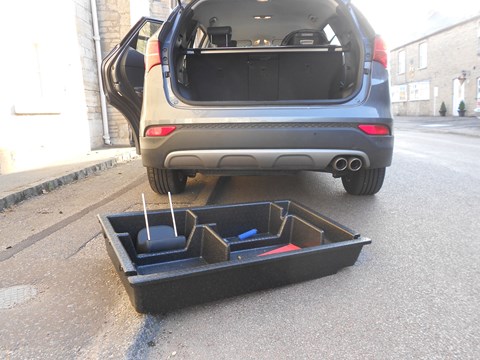
Month 6 running a Hyundai Santa Fe: it’s been facelifted!
Like mobile phone makers, car manufacturers absolutely insist on updating their products quicker than customers could possibly want. It’s a momentum/desire strategy, keeping you ever hungrier, ever keener, always in the game. By the time you get your hands on the tweaked model the next one’s around the corner, and you’ll soon start desiring that. And so it goes on.
A sign of the pace of this process is that the Santa Fe has been mildly facelifted even before the end of our half year with the 2014 model, courting the risk of peeing off customers still two years away from paying off the finance on what is now a lesser car. So I approach MY15 with trepidation, hoping that its enhanced trinketry won’t break up what has become a firm friendship between me and Britt (EK64 LND – you figure it out).
I think we’re going to be okay. I think our love is stronger than the deletion of the cigar lighter and the covering of A, B and C pillars in cloth. We’ll withstand the temptation of an auto-dimming rear-view mirror, rise above the need for heated rear seats, and even stay together despite the now very real sense of deprivation wrought by Still Having To Adjust The Driver’s Seat Manually. The lights, however, could have been a marriage wrecker, had they added full-bore, fully adaptive xenons to our Premium-spec model. But they didn’t, opting instead to save those for the top-spec Premium SE only. A pity, as only last month I was complaining in these pages of how poor the front lamps are. It’s a disappointment. Consolation can be found at the rear, where the lights are now full LEDs, and their sassy signature adds a surprising helping of extra modernity to the rear profile. Great news for those in the car behind, but not for the driver, even if he is now sitting behind a steering wheel made of slightly nicer leather.
One thing I would have loved is a panoramic sunroof, but £32k still doesn’t buy me that. Now, about my next phone…
By Greg Fountain
Month 5 running a Hyundai Santa Fe: a whistlestop tour around Santa Fe
It’s a workhorse, not a show pony, so not all the details are glitzy. Good or bad, a few bits stand out.
1) ‘Hang on, lads, I’ve got a great idea’
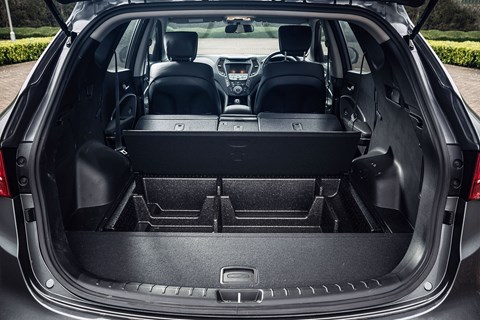
The boot looks big enough to host a remake of the last scenes from The Italian Job. Seats fold flat at the pull of a lever, creating a humungous 1680 litres of cargo space, with the bonus of cubbies under the boot floor. Seats up and the capacity suffers like a post-Taylor-report footie stadium, but at 585 litres it’s still a stadium.
2) Early-colour-telly-spec touchscreen
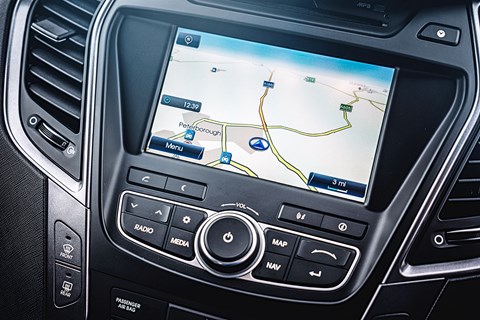
Seems incredibly churlish to criticise a colour touchscreen, but this isn’t the Santa Fe’s finest hour. Low-resolution display looks more washed out than Uncle Brian’s TV that day in 1972 when I first saw Star Trek in colour. Graphics are low-tech too, and it takes three finger-stabs to induce some functions to perform.
3) Better-than-they-look seats
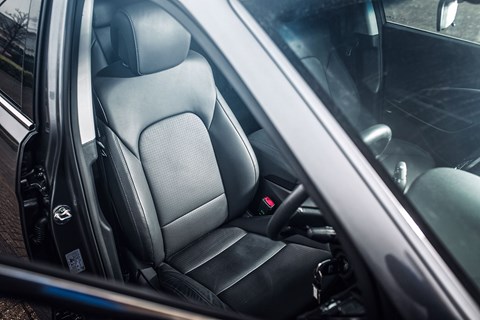
They may be leather, but when I first saw them the seats looked flatter than a Top Gear producer’s nose. Not so – with such modest power and tight body control you don’t need to be nail-gunned into a bucket like an Apollo astronaut. And after a long stint it’s nice not to have to pay for a chiropractor along with 50 litres of diesel.
4) Not-as-bright-as-they-think headlamps
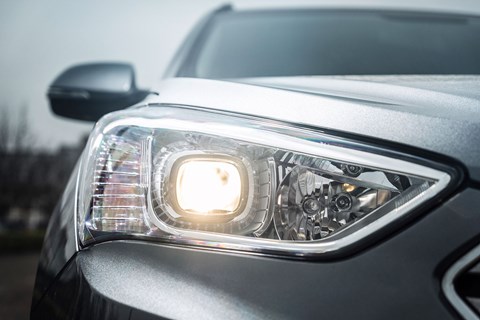
Headlight tech is moving at a dizzying pace, but nobody’s told Hyundai. In a world of LEDs and matrix lasers the Santa Fe makes do with, err, halogen bulbs. Premium SE models get xenons, but when driving ours at night you can only see as far ahead as 1998. Being followed by an Audi is something out of Close Encounters.
By Greg Fountain
Month 4 running a Hyundai Santa Fe: what happens when it’s pitted against a Porsche Cayenne?
Hyundai vs Porsche. That’s a match-up to set stuffy road-testers steaming with indignation. ‘Harrumph!’ they’ll say. ‘You can’t compare apples with oranges!’ But you can, you see – they’re both fruits, after all, and the Santa Fe and Porsche’s Cayenne are both built to do the same job. So we suspend disbelief, forget the 64bhp/116lb ft/£17k discrepancy between the two, and honestly consider this question: when you peel away the Porsche badge, how big is the gulf?
What’s great about the Santa Fe is that it’s fit for purpose. They didn’t try to make it a sort of sports car, but instead gave it exceptionally compliant ride wedded to confident body control, steering that doesn’t inexplicably weight up to muscle-tearing levels as you turn into your street, and an interior made of wipe-clean plastic rather than quick-ruin leather
To drive the Cayenne, of course, is to experience that strange alchemy only Porsche seems to be able to achieve, by which a tall, rut-ready SUV can steer and corner and accelerate without adhering to the laws of physics. Damn them. The Santa Fe gives it a good go, but can’t quite achieve that sense of plantedness when pressing on, and its engine does start to complain when you forget yourself and try to keep up with the more refined, more gutsy German.
But this is no walkover. When both cars are pristine the Porsche feels way nicer, but grub them up a bit, fill them with kids , grass cuttings and bicycles, and suddenly the Hyundai is the one for the job. Look, I’m not seriously saying I’d rather have the Korean than the German, but I would rather be richer, calmer and less hated by other road users, and to this end the Santa Fe wins hands down.
By Greg Fountain
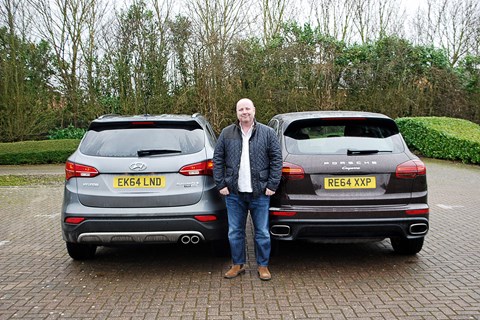
Month 3 running a Hyundai Santa Fe: our pretty much brand-free SUV is working a treat
With dead-eyed accuracy a friend asked me: ‘what made you choose one of these?’ The last time he asked me that (as opposed to the more usual ‘what’s it like?’) was when I ran the lesser-spotted Honda Legend, which tells us quite a bit about the Santa Fe’s profile – or lack thereof.
I told him I’ve had a soft spot for the Santa Fe since we first met in 2001, and that the plan was to establish if there is a case for a mid-range SUV devoid of brand equity but equipped with more pragmatic talents. With that in mind, the Santa Fe is way cheaper than any Land Rover Discovery, yet can offer seven seats, and has more boot capacity and cabin space than a BMW X3 – or a Disco Sport. Its fuel economy and CO2 emissions comfortably beat Honda’s CR-V, and shade the Disco Sport, and its five-star NCAP rating beats the (also five-star) Kia Sorento in each of the four categories (adult, child, pedestrian and safety assist). Hyundai’s five-year unlimited mileage warranty – which includes roadside assistance – beats the three-year cover offered by Land Rover, Honda, VW, BMW and most others (and even Kia’s seven-year deal is limited to 100k miles). Sensibleness oozes from every pore then, but round here that tends to last about as long as Al Murray’s election chances. Question is: do we love it?
Love? No. Respect, enjoyment, satisfaction? Indeed. It rides brilliantly, performs with a gruff energy and scores a very low annoyance rating (the fuel-filler cap froze shut one day, causing five minutes of forecourt humiliation, there’s no clock except on the nav screen, and the ‘welcome chimes’ drive you nuts until you figure out how to disable them in ‘settings’). Plus, winningly, EK64 LND daily reminds me of Britt Ekland.
By Greg Fountain
Month 2 running a Hyundai Santa Fe: a road trip to Wales
A trip to Wales put 500-plus miles on the Santa Fe in a few days, and while it wasn’t exactly off-roading, there were some lanes on the Black Mountains steep enough to leave nothing to see through the windscreen but stars (had there been any).
This being Wales, it rained hard enough that only white lines distinguished streaming roads from actual streams. The Santa Fe was rock solid throughout – surefooted, uncomplaining, grippy and torquey. Occasional forays onto sopping 45-degree grass demanded the on-demand four-wheel drive, and it sorted everything out with less fuss than an experienced midwife.
I really like this car – it feels proper tough, yet on the long, fast A-roads, roundabouts and tightening B-roads between here and Brecon it gets the manners right. The ride, on dampers stiffened specially for us Brits, is surprisingly composed, and body control is tidier than an OCD sufferer’s sock drawer.
You do need a heavy boot to get the four-pot diesel to take off, but once the auto ’box has hurried you into sixth it settles to a potent, satisfying cruise. Chief irritation? The ‘welcome’ chimes that sound like you’re booting a laptop every time you climb aboard.
By Greg Fountain
Month 1 running a Hyundai Santa Fe: the introduction
Santa Fe, New Mexico, population 70,000, America’s oldest state capital. What does this have to do with a medium-sized Korean SUV? Not a lot, except that the very wise folk at Hyundai correctly reasoned back in 2000 that the way to break the North American market was not to launch a car called Changwon or Uiwang. Their wisdom was ratified by sales success in America, and even though they didn’t change the UK model’s name to Leamington Spa, we Brits kind of got the Santa Fe too. We’ve bought 37,500 of them since 2001, and snaffled 4200 last year alone.
Here we have the third-generation model, confusingly dubbed ‘New Generation’, which adds to the Santa Fe’s established good-value/robust/unfussy DNA a good deal more technology and an aggressively chromed-up, Yank-tank belligerence around the jawline. As one of the bold new breed of stylish Koreans it succeeds in making premium Germans look rather plain and the Japanese a little tired (though having seen off the Freelander it will have sleepless nights over the arrival of Land Rover’s spangly Discovery Sport). Battles to come.
Our car’s ‘Premium’ badge means it’s the current five-seater range sweet-spot (the Premium SE gets two extra seats and inessential lush goodies), and the kit list is so comprehensive we’ve only managed to add a paltry £585 to the base price – that being the cost of ‘titanium silver’ metallic paint. Which means we’re on the road for £32,315 – slightly less than an equivalent Honda CR-V, slightly more than a Toyota RAV4 and heaps cheaper than a decent Freelander 2. So, while Hyundai doesn’t own value, you’ll find it rolling up its sleeves with gusto when they shoot the mid-market SUV fight scene.
Credible stuff then, but in the corner of the room an elephant lurks. Why are we running a Santa Fe? It’s not a car that’s only just been launched, it’s neither the best nor the worst nor the cheapest nor the most desirable car in its class, and keen drivers will dismiss it as if it had just handled on the goal-line. It’s all my fault really. Since driving the very first Santa Fe on its launch back in 2001 I’ve held the view that unfashionable SUVs are often hidden gems, shielded from readers by a mix of snobbery, tradition and road-tester bravado. Take a poll of 50 motoring journalists and find out how many would take an inferior Land Rover over an uncool Santa Fe. Yes, of course you get more steering feedback from a Freelander than from this Hyundai, whose variable power-steering system (called FlexSteer) is more numb than a Sherpa’s nose, and yes the Santa Fe’s 2.2-litre diesel engine’s mantelpiece is empty of awards for power delivery or refinement. But with 311lb ft of torque it pulls like Benedict Cumberbatch at a mums’ speed-dating evening which, added to the likely benefits of reliability and low running costs (the five-year warranty includes five years of roadside assistance and an annual vehicle health check) nicely richens the mix.
So, in my role as official bucker of trends (at least, I think they said ‘bucker’) I’ve decided to sample the case for middle-market solidity and the unfashionableness for which I’m well suited.
By Greg Fountain
